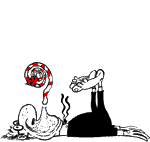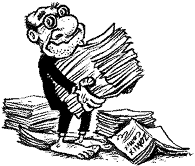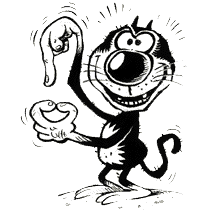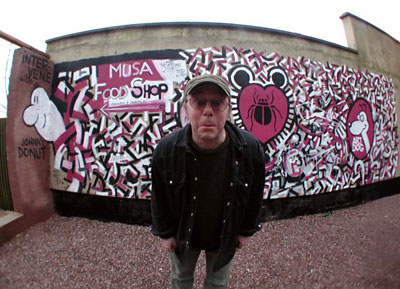The D'log interview for Artsnet: HUNT EMERSON
Profile: Hunt Emerson was born in 1952 and has drawn cartoon illustrations and comic books since the early 1970s. He became a key figure in the Birmingham Arts Lab of the mid/late 70s. Since then he has kept up a steady stream of published work from his Handsworth studios — including over twenty comic books and graphic novels, mainly in partnership with Knockabout Comics. His acclaimed graphic novels include The Rime of the Ancient Mariner, Casanova's Last Stand, and Lady Chatterley's Lover. His characters include Calculus Cat, the sexual satire of Firkin the Cat, the critically-acclaimed Citymouths, and many more.
His comic strips have been translated into ten languages, and he has had work published in nearly all underground comic anthologies. His penmanship appears in publications as diverse as Fiesta, Fortean Times, The Wall Street Journal Europe, The Bookseller and Bike magazine. He has also worked widely in advertising and book illustration, including illustrating the Collins English Guide series and a new children's book series for Walker Books.
Hunt Emerson has won numerous major awards — in 2000 he was chosen as one of the 75 European Masters of Cartooning of the 20th Century, by the CNBDI ('Centre Nationale de la Bande Dessinee et de l'Image', France). Other awards include Humorous Cartoonist of the Year 1982 given by the Society of Strip Illustration, International Album of the Year 1989 by Kemi International Festival, and the Grand Prix de la Festival 1995 by the Pertuis Comic Festival, France.
A quick trawl of the web and newspaper archives easily gathers a host of acclaim: "the funniest cartoonist in the UK"; "one of the greatest surreal cartoonists"; "Britain's national treasure"; "quite simply Britain's funniest and most visionary cartoonist"; "one of the best and weirdest British comic artists ever"; "England's finest. Full stop."; "one of the world's top comic artists"; "for sheer penmanship there are few who can touch him"; "Why isn't this guy a household name?", and of his Citymouth strips, "definitely the product of a mind on a wavelength untouched by most humans."
ARTSNET: Hunt, welcome. Your most recent work was seen at Intervention, a major Birmingham show which took over a row of empty houses in Handsworth, and turned them into a vast art gallery. How did you get involved?
HUNT: Intervention, yes. Well, Intervention has closed now, I've slept 12 hours, and I'm starting to find my way back to real life. What an experience it's been! Dave Pollard, the moving force behind the show, is a mate of mine and a neighbour of my girlfriend. He lives in a house I used to live in, which was the site of the first Sozo Collective show, Alchemy, last summer, and I had a painting in that show. When Intervention came up I was determined to have a bigger part in it, and I was one of the first into the derelict houses in November last year. It's been a really exciting project to work on, with a wonderful group-feeling generated as we knocked down walls, cleared rubbish, painted and scrubbed and hauled.
ARTSNET: Well, you're all to be congratulated, not just for the show, but for how you've also built a genuine spirit and fellow-feeling; which won't be knocked down along with the houses. Your own work in Intervention is an 'Observatory' in an attic room. What are the themes, and what might it lead to — a graphic-novel history of astronomy?
HUNT: 'The Observatory' I built echoes an interest I have in the history of astronomy and the growth of ideas about the universe. I was originally going to have portraits outside the room of Copernicus, Tycho Brahe, Kepler, Gallileo, and Isaac Newton, but that went by the board. But mainly I did the room 'cos it seemed like a nice idea. Will it lead on to anything? No. Although... my Observatory is proving to be one of the popular hits of the show, especially with children. I've had any amount of requests to decorate bedrooms. It has also been popular in another way. One night the room got slightly damaged by late night dope-smokers, local youth, who were 'chilling out' there. No harm intended, but no thought given to anything but their own requirements.
ARTSNET: You had a painting in the first show, Alchemy. Do you do much painting?
HUNT: Hah! I think I can safely say I don't do any real painting now. The canvas I put into Alchemy is one I painted in about 1994, while I was doing some voluntary-work running comics workshops with recovering drug-addicts. It's a portrait of blues singers; Howlin Wolf and Sonny Boy Williamson. I did another canvas at the same time, of Bo Diddley, but never finished it. Since then I haven't done any.
ARTSNET: It's a pity to hear that; I heard you did an influential The Beat record cover, and all their adverts and posters in the 80s. And there's a tale of how you impressed the band by doing a gigantic painting overnight, showing them being engulfed by a multi-coloured tidal wave. Later used as a record sleeve, apparently.
HUNT: Yeah, their second album. I hated it — my painting, that is — but there was no more time to do a design, and the band couldn't make up their minds on anything else. But that time working with the Beat was exciting and good fun. Great music, and I got to see The Specials and things like that. There are times when I still 'keep my hand in' — I did paint a big mural outside at Intervention. Over a couple of days — nothing serious, just messing about with red, white and black paint, making an "abstract".
Hunt Emerson & his mural at Intervention, February 2002. (Photo by Julian Bull)The show kept growing like that. People kept putting more and more things in, right to the end. There was even a young guy who put a couple of carved wood pieces in on the last afternoon; set them up in a room, painted the walls white and put gravel on the floor, all for the final three or four hours of opening. Mind you, he timed it right; the last-night party for Intervention was wild! I thought it would be the artists sitting around the fire being nostalgic; but not a chance! The place was heaving, and the party went on all night.

ARTSNET: Yes — if success was ever earned and deserved, it was by Intervention and its organisers and artists.
HUNT: After you covered the opening night of Intervention for ARTSNET, the show had been open for just over a week before it started attracting a lot of interest. And even now the buzz is amazing. One might almost say Groovy. It all reminded me of the Birmingham Arts Lab, which I was part of in the 1970s — a loose collective of creative people working together with no pretensions or 'stars'.
ARTSNET: I remember the tail-end of the Arts Lab. For the benefit of readers; the Arts Lab was hugely influential; it grew to become one of the leading alternative centres for the arts in the country during the 70s. A few years ago the Birmingham Museum and Art Gallery put on a retrospective show about it — there should be some catalogues still knocking about. And you gave the Guardian cartoonist Steve Bell his first break, Hunt, I believe?
HUNT: I did?
ARTSNET: You published him in the Arts Lab's Street Comix, back when he was still living in Birmingham. I remember picking up those various Arts Lab comix, back when Nostalgia was still in that tiny little shop on the corner of Hurst Street. Talking of which; what's your opinion of the current regeneration of Birmingham's city-centre?
HUNT: I've lived in Birmingham longer than I would ever have believed possible. I think the regeneration is a great thing, and much needed. The city doesn't have much history left since the last War, and the many scrape-it-clean-and-rebuilds that have happened since then. But I don't 'use' the city very much — I never 'go shopping' in the centre, or go to any clubs or bars. The most I might manage is going to the theatre now and again.
ARTSNET: Yes, I think you've highlighted an increasing problem there; artists are encouraged to live and work and do projects in run-down city areas, giving the area a 'cultural buzz'. Once the foundations for regeneration are firmly laid the artists get priced out by shopping, cheesy theme-pubs and tweeny wine-bars. The area then slumps into the commercial blandness you can find in any British city.

ARTSNET: Anyway, let's turn now to talking about your work. There's a huge Krazy Kat influence in your work; how did you manage to find out about Herriman's sublime work, and see it during the 70s?
HUNT: I first heard of George Herriman and Krazy Kat in George Perry and Alan Aldridge's Penguin Book of Comics, way back when I was first starting to draw comics.
ARTSNET: The Penguin book was, what... 1967? And still around in the mid/late 70s, constantly reprinted. I remember it well. It was a very good primer on the sheer range of and history of the strip cartoon. They followed it up with a wide-ranging Penguin Book of Political Comics.
HUNT: I never saw the Political Comics book. The original book amazed and delighted me. I didn't know that comics could be so 'off the wall' — I didn't know very much about them then.
ARTSNET: No-one did; aspiring British artists were stuck. For long-form narrative comics we had the violent Action British weeklies, digest reprints of girl's boarding-school stories from the 50's and 60s, or the cliched men-in-tights superhero monthlies from the USA. And if it hadn't been for your Arts Lab comix, I suppose the closest we could ever have come to 'off the wall' would have been poor old Leo Baxendale, who was slaving away for a pittance at The Beano.
HUNT: I didn't know much about any other comics at all. From the Penguin Book I also learned about The Spirit, Jules Feiffer, the Yellow Kid, and a lot of other things that are now regarded as Basic History. I went on to see more Krazy Kat, via a beautiful series of comics published by the Real Free Press of Amsterdam. They published some high-quality comics back then. Their in-house designer was Jooste Swarte, who is today still one of my favourite artists. And, of course, I started seeing the American undergrounds.
ARTSNET: How did you get your hands on those?
HUNT: The underground comics were all over the place then. I bought a lot from Carol Bennett, who was running a 'head shop' in Birmingham.
ARTSNET: 'Head shop', now there's a term which hasn't been in use for a while. You were also part of that constant stream of rock & pop bands that came out of Birmingham & the Black Country in the 70s and early 80s. I think the first time I saw your name again after the Birmingham Arts Lab comix was the Elvis Costello and Sex Pistols posters you did for the NME? Then you were contributing to the distictive design of the Mod revival, doing all the branding for Birmingham's The Beat. Then work for the sublime genius of the Jazz Butcher, a sleeve for the American blues honker sax-player Big J. McNeely, and I remember your story about the birth of punk rock in the Big Book of the '70's. One of your strips even inspired the house rock-band of the notorious French circus-troupe Archaos to call themselves Thunderdogs. So all in all I'd say you're probably the nearest thing Britain has to a cartoonist rock star!
HUNT: Well.... at the moment, this 'rock star' has just lost his gig. Black Label magazine, for which I do a strip called Bob and the Boss about a bloke with a giant talking penis, has cancelled my strip due to economic pressures. And cut my income by 25 percent in the process. Still, I have my other main client which is Fortean Times, for whom I write and draw a page each issue called Phenomenomix, along with an illustration feature.
ARTSNET: I've seen those strips in collected book form, under the title of Aliens Ate My Trousers. I can see that sort of strange-but-true story being very amenable to your style!

ARTSNET: I'd say your web-site's animated .gif images show a fledgling talent for animation too. Has interactive animation ever appealed, using the new animation software
?
HUNT: Not really. I'm a full-time freelance cartoonist and illustrator, and I do whatever comes along. I don't have time any more to learn how to do these things purely 'on spec' — and no-one's ever asked me to do them for money.
ARTSNET: Someone somewhere should be willing to give you some funding to develop animation ideas, when you have such distinctive characters, surely?
HUNT: Maybe. I don't know where to find this sort of offer.
ARTSNET: Does it get boring, or do you still love the work?
HUNT: One starts one's professional life ready to work all night, throwing ideas around and ready to experiment. But after twenty-five years in the biznizz, I'm afraid it's very much "a job". Yeah, it gets boring! There's lots of things I'd rather be doing than drawing. But at the same time it's a great job. Sure beats working in a factory.
ARTSNET: Have you ever thought of doing a daily newspaper strip?
HUNT: No, I don't work in that sort of concise way. It's a very different field to comic books, and very intensive. I have a hard enough time writing stories of one page for Fortean Times — I'm at my best with 16 pages to play with, but nobody ever offers that sort of space.
ARTSNET: You've done your own critically-acclaimed comic books; do they make their costs back?
HUNT: Eventually, if they sell out. There isn't a huge market for them. One of the most successful has been The Rime of the Ancient Mariner. We recently sold out of the second edition of that book, which is very satisfying. We'll reprint it again, but not immediately.
ARTSNET: And the success hasn't only been in the sales. Doing Ancient Mariner has meant that you're probably the first British cartoonist to have an academic — from Stanford no less - write a serious analysis of your work, published as a chapter in the volume Satire and Romanticism (St. Martin's Press, 2000). And your Casanova's Last Stand has a complete page on show at the French National Library's site. I can't quite imagine the British Library having the same regard for a living British comic artist, somehow.
HUNT: Both the publishers and I both thought that Casanova's Last Stand was a great book, but it's still only sold about half it's first print-run, and it was published in 1993. We only do print runs of 5000 — less, if we can get the economics right — so you can see there's not a lot of money in it.

ARTSNET: And you also did Lady Chatterley's Lover in comic form. Which brings us to talk of erotica. Does the Firkin the Cat / Fiesta connection ever draw brickbats from feminists? Does Firkin express any of your own attitudes to Britain's sexual repression?
HUNT: When I first started doing Firkin I used to get trouble from some of my women friends, but that was at a time when feminism was very militant anyway. These days nobody cares very much. Most people I know don't see my work at all, whether it's Fiesta work or any other. In a world where erotic magazines exist, Fiesta is one of the less virulent ones.
ARTSNET: In the 80s it used to be, perhaps still is, the tamest soft porn mag in the developed world. And the mag most willing to laugh at itself and at sex too. Firkin the Cat has been running in Fiesta magazine since 1981; I would have thought you might have run out of inspiration by now, although I admit it's a huge subject.

HUNT: Sure, Firkin is still going, and Tym Manley is still writing it. We like to point out to people that all the Firkin stories are closely based on personal research. The Firkin comics are a debunking view of the sex industries, if they're anything, but hey! they're only bloody comic strips after all!
ARTSNET: Ok, I believe you! :) What new personal projects are you working on?
HUNT: I don't have time to do them any more.
ARTSNET: That's sad. If this were France or Japan — where they value comics equally alongside the other art forms — you'd be cherished as a national treasure and funded handsomely, I'm sure.
HUNT: Hah. Having said that, though, I am determined to do something new this year, but I haven't a clue what it will be. First thing will be to get a week clear, go away somewhere quiet, and think.
ARTSNET: Where do you go to think?
HUNT: I've never tried it before, so I don't know. I'd thought of going to a friend's caravan in North Wales — though, since I lost the Black Label magazine job I may not be able to afford to take the time off. I'll just have to think at home. One thing for sure is that it's no good me going anywhere with any attractions of its own — no good long walks or anything. If I go on long walks 'to think' I don't do any thinking. I just get distracted by exploring hedgerows and byways. I have to have quiet, and sit in front of a blank sheet of paper and sweat it out.
ARTSNET: The next time someone tells me that 'Genius isn't about sitting alone in an attic sweating for ideas over a blank sheet of paper', I'll remind them of you. Hunt Emerson, thank you.
Hunt Emerson's web-site is at www.largecow.demon.co.uk. The site has lots of cartoons, full comic strips, fun and laffs. Plus the opportunity to invest in buying original artwork.3000 words. Updated: 17.01.07.

